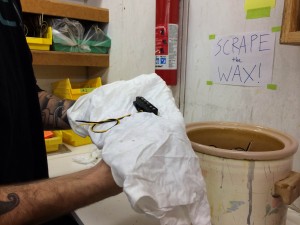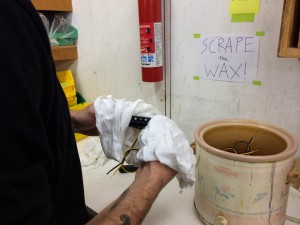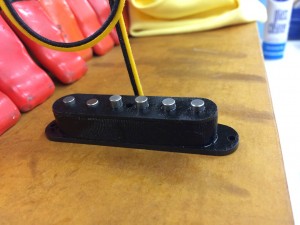We will, that’s who!
Potting is the process of soaking the pickup in melted wax, in order to saturate the components, which will isolate them and reduce movement of the coils. Because of this, potted pickups have reduced likelihood of excessive handling noise, microphonic feedback or mechanical failure. However, if a pickup is potted too much, the pickup can often sound lifeless and dull, lacking character and “vibe”.

Every Lollar pickup is wound with a specific amount of tension for a tight coil, and then potted, based on the particular model and what has been found to be the optimum balance of effective isolation and good “vibe”. Furthermore, Lollar pickups are potted just enough so you can actually tweak the amount of microphonics you get with spring tension. Our method of coil tensioning and potting ensures that your pickups will not become loose over time, so you can be sure the way it sounds today will be the same 20 years from now.
The following is an excerpt from an interview Jason Lollar did with 300guitars regarding pickup potting…
300guitars: Potting is very important for preserving a pickup’s windings over time and keeping it stable from excessive feedback at high volumes. Can a pickup be over-potted and lose some of the “vibey” quality?
Jason Lollar: Most of us can easily hear the vibe that a microphonic or slightly microphonic pickup has, it’s like reverb almost or harmonizing a scale—a little extra air in the sound. If you over pot them, you’ll kill it for sure. Every pickup I make is potted to some extent, every design has a different level of potting and I time it closely. I have a really consistent result the way I do it. I use to not pot anything—everything I made was unpotted. I mistakenly attributed potting to sloppy manufacturing and I printed it in my book. Now that same line I said has become part of the dogma going around but after making thousands of pickups I realized if I drop this pickup the whole coil is going to expand like a balloon and it can even come off the bobbin. This happens with vintage pickups all the time, un-potted coils can shift or slip and become un-useable, they can short out or even come completely apart!
On Fender coils, part of what holds them together is the potting. The trick is to get a certain level of microphonics you can hear so the pickup is sweet and yet have enough to prevent the pickup from becoming more microphonic over time or at worse falling apart!
It takes a lot of attention to do it right. If you looked at my Fender style pickups most people would not be able to tell they are potted—I am meticulous about wiping off the wax; there is no reason for sloppy work under any circumstance except for ineptitude or having to do something in a hurry. Not that I am slow, I don’t doddle. Once in a while I will have to pot something more for a guy using a lot of gain. Most people haven’t caught on to this yet (I need to make a video on it) but the way I pot my pickups you can actually adjust the amount of microphonics you get by clipping down the springs to get a looser mounting on the pickup so that you can get more microphonics. You can even pop the metal plate off the bottom of the Tele bridge pickup to break the wax seal. A vibrating reflector plate on the bottom on a Tele bridge pickup will definitely increase the amount of microphonics to the point it will be difficult to control which is a lot of the sound Roy Buchanan use to get. On the other hand you can get less microphonics by tightening the mounting screws to put more pressure on the springs holding the pickup in or stuff a little bit of foam under the pickup to keep it mounted more solid. If you wanted to eliminate even more of the microphonics you could replace the springs with surgical tubing. Vintage fenders used surgical tubing but my pickups are designed with springs in mind.




